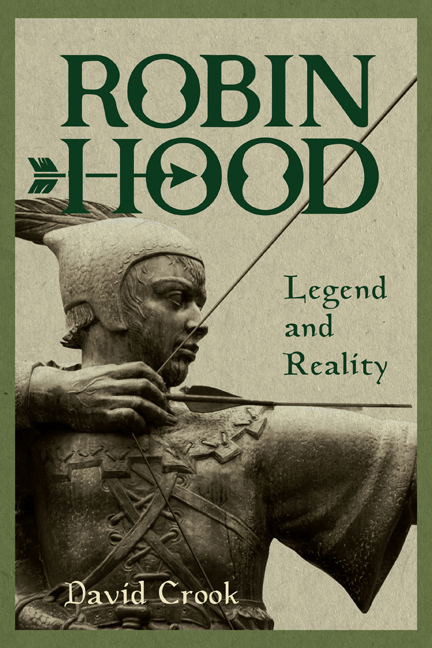Book contents
- Frontmatter
- Dedication
- Contents
- List of Maps and Illustrations
- Preface and Acknowledgements
- List of Abbreviations
- Introduction
- PART I THE LEGEND AND ITS INTERPRETERS
- Chapter 1 The Medieval Tales of Robin Hood
- Chapter 2 Chroniclers, Revellers, Playwrights and Antiquarians, c.1420–1765
- Chapter 3 Editors, the Folklorist and the Archivist, 1765–1889
- Chapter 4 Folklorists, Literary Scholars and Historians: Robin Hood in the Twentieth Century
- Chapter 5 The Robin Hood Places
- PART II OUTLAW AND EVILDOER OF OUR LAND: THE ORIGINAL ROBIN HOOD
- Chapter 6 The Robin Hood Names
- Chapter 7 Robin Hood and Criminality
- Chapter 8 Law and Disorder in Yorkshire, 1215–1225
- Chapter 9 The Sheriff, the Fugitive and the Civil Servant
- Conclusion
- Bibliography
- Index
Chapter 2 - Chroniclers, Revellers, Playwrights and Antiquarians, c.1420–1765
Published online by Cambridge University Press: 16 September 2020
- Frontmatter
- Dedication
- Contents
- List of Maps and Illustrations
- Preface and Acknowledgements
- List of Abbreviations
- Introduction
- PART I THE LEGEND AND ITS INTERPRETERS
- Chapter 1 The Medieval Tales of Robin Hood
- Chapter 2 Chroniclers, Revellers, Playwrights and Antiquarians, c.1420–1765
- Chapter 3 Editors, the Folklorist and the Archivist, 1765–1889
- Chapter 4 Folklorists, Literary Scholars and Historians: Robin Hood in the Twentieth Century
- Chapter 5 The Robin Hood Places
- PART II OUTLAW AND EVILDOER OF OUR LAND: THE ORIGINAL ROBIN HOOD
- Chapter 6 The Robin Hood Names
- Chapter 7 Robin Hood and Criminality
- Chapter 8 Law and Disorder in Yorkshire, 1215–1225
- Chapter 9 The Sheriff, the Fugitive and the Civil Servant
- Conclusion
- Bibliography
- Index
Summary
Chroniclers and historians: early attempts to date Robin Hood
The Vision of Piers the Plowman from the late 1370s or early 1380s makes the earliest dated reference to the existence of tales of Robin Hood. Other references or allusions to the outlaw occur in England in the late fourteenth and early fifteenth centuries, from the time of Geoffrey Chaucer (d. 1400) onwards. Chaucer's yeoman, who appears in the prologue of the Canterbury Tales, closely resembles Robin: both are of yeoman social status, skilled archers and carry bows and horns, and wear hoods. The Lettersnijder edition of the Gest, printed in 1508, even illustrates Robin by reusing the image of Chaucer's yeoman from the beginning of Pynson's printed edition of the Canterbury Tales, of c.1491, something first noticed by Frank Isaac in 1930. Prominent among explicit references to the outlaw are criticisms by clergy. The treatise Dives et Pauper (c.1405-10) attacked those who preferred to visit the tavern to hear ‘a songe of Robynhode’ rather than attend Mass or Matins. Two sermons also referred to the legend with disgust: one the undated context of which is a manuscript of an Oxfordshire parish priest, the other preached before king and parliament by the chancellor John Stafford, bishop of Bath and Wells, in 1433. The first complained that many men preferred fables to the Gospel, and a ‘romaunce of Robyn Hode’ to St. Paul's Epistles; the second thought that the tales threatened social harmony and respect for the clergy, and the people paid more heed to ‘wanton prophets’ like Robin Hood than to the prophets of God’. Other references, however, are not overtly or even implicitly critical. A scribbled note, made in the early fifteenth century on a spare page of a fourteenth-century liturgical manuscript which survives in Lincoln cathedral library, perhaps by someone practising cursive handwriting and translation from English into Latin, merely describes the outlaw, said to be standing in Sherwood, his clothing, and his possession of 24 arrows. In 1429 occurs the first example of the use of the phrase ‘Robin Hood in Barnsdale stood’ in verbal pleading by a serjeant at law in a case heard in one of the central courts of common law at Westminster.
- Type
- Chapter
- Information
- Robin Hood: Legend and Reality , pp. 34 - 65Publisher: Boydell & BrewerPrint publication year: 2020



